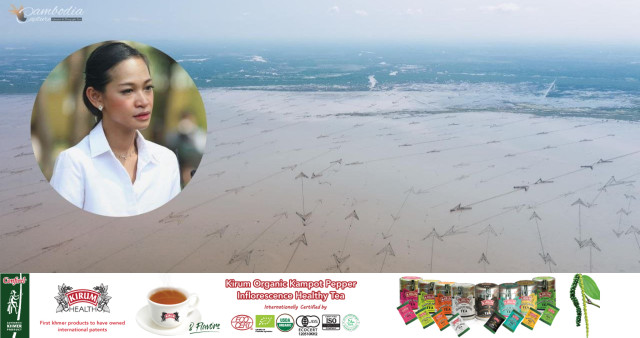Arrows in the Tonle Sap Lake Are Fishing Nets: Agriculture Ministry Says to Tackle Criticism

- By Lay Sopheavotey
- February 27, 2024 7:00 PM
PHNOM PENH – Im Rachna, the spokesperson of the Ministry of Agriculture, Forestry and Fisheries, said that the ‘arrows’ seen in a photograph that went viral on social networks are just fishing nets dispatched over the Tonle Sap Lake’s waters. Rachna called on the public to be temperate after strong criticism recently soared on social media.
The picture Rachna is referring to is an aerial image of fishing nets forming multiple arrows on the water. It was taken by Dyna Pisith, a professional photographer, during a trip to Kampong Thom province’s Phat Sandai floating village.
Once posted on social media, the picture sparked public concern about overfishing in the Tonle Sap Lake.
Im Rachna said this type of fishing gear is legal as long as the mesh size and the length of the nets are in line with the ministry’s rules. She urged the public not to jump to conclusions, adding that the ministry will further investigate the matter.
“The ministry conducted a site visit [on Feb. 27] in the area to verify with the images shared on social media,” Rachna said.
“Experts from the ministry will further examine and evaluate whether the many fishing nets in this area could affect the fish movements and whether the mesh size and lengths are legal,” she added.
“The ministry does not only work when issues arise. The fisheries administration always patrols and keeps an eye on the mesh size and the lengths of those fishing nets.”
The ministry’s spokesperson added the ministry works with fisheries officials, experts, and provincial authorities to investigate all fishing gear that has been installed in the Tonle Sap Lake.
This type of fishing gear forms an arrow from an aerial perspective. But Rachna said the pillars supporting the nets might have already been damaged, so the public has to be careful before drawing conclusions.
“So far, the ministry has worked closely with the local fisheries to ensure the fishing could support the people’s livelihoods. The ministry has put its utmost efforts to ensure there are no illegal fishing crimes,” she said.
Originally written in Khmer for ThmeyThmey, this story was translated by Rin Ousa for Cambodianess.















